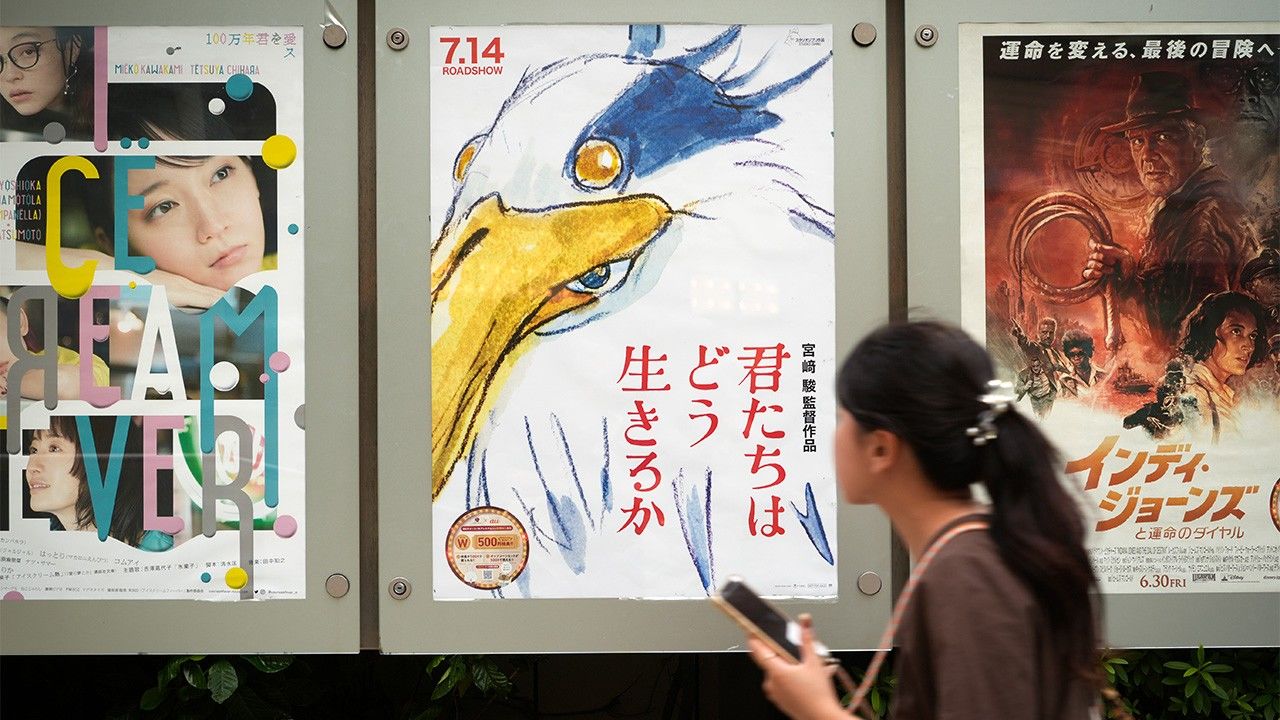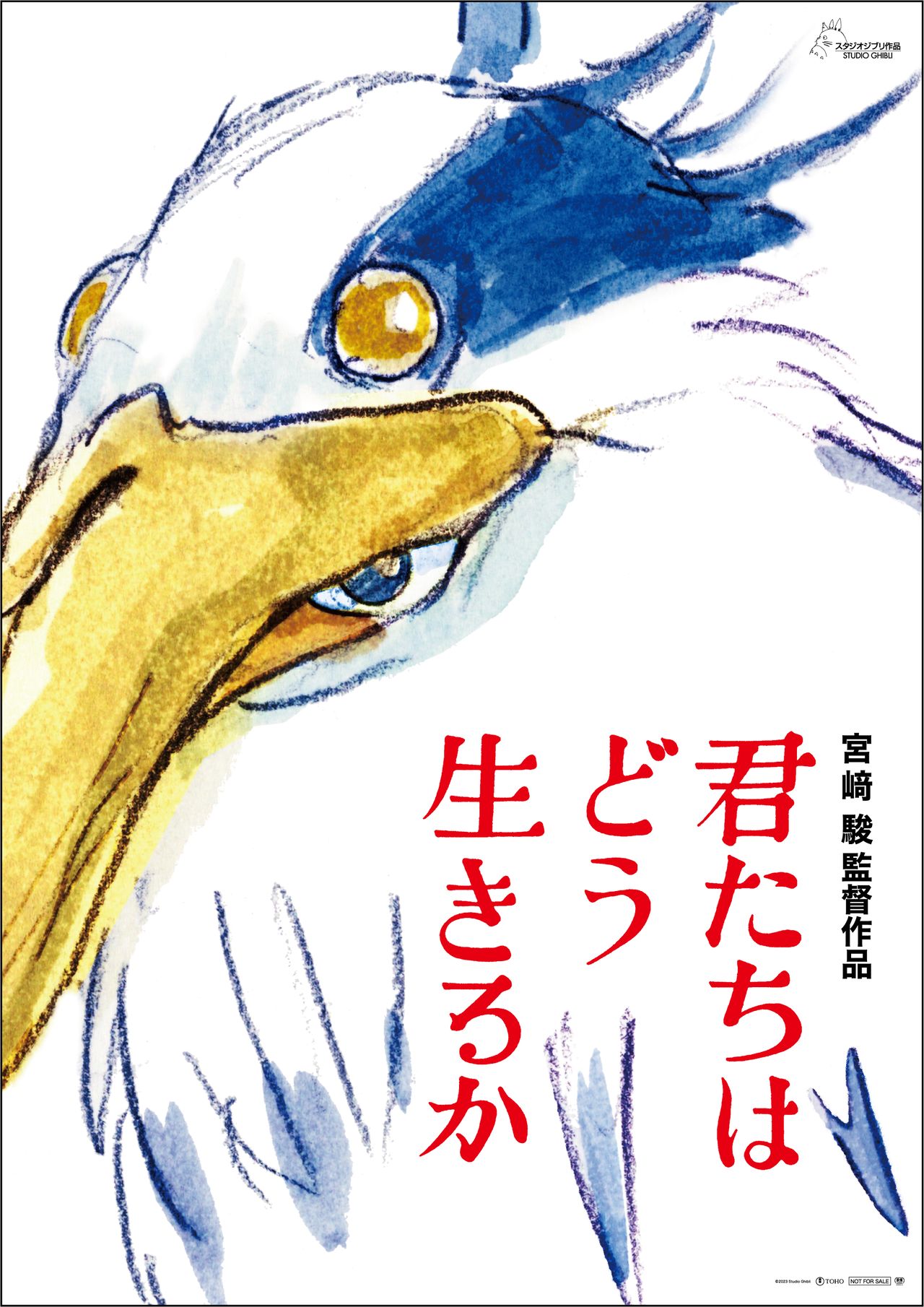
“The Boy and the Heron”: Miyazaki Hayao Carries Viewers into a World of Stories
Cinema Anime- English
- 日本語
- 简体字
- 繁體字
- Français
- Español
- العربية
- Русский
Journey to Another World
Following its Japanese release on July 14, Miyazaki Hayao’s latest film is set to show in North American theaters later this year under the title The Boy and the Heron. Its original Japanese title is taken directly from that of Yoshino Genzaburō’s novel Kimitachi wa dō ikiru ka (translated by Bruno Navasky as How Do You Live?). This tells the story of a 15-year-old boy called Copper and how events at school and interactions with friends and his uncle lead him to grow as a person and reflect on his place in society and the meaning of life. Miyazaki was deeply moved by the book, although his new film is not an adaptation.

The Boy and the Heron, written and directed by Miyazaki Hayao and produced by Studio Ghibli, is now showing across Japan (in Japanese only). (© 2023 Studio Ghibli)
The film opens with the sound of air raid sirens reverberating across the Tokyo sky. In 1944, as World War II approaches its final stages, a boy called Maki Mahito evacuates to the suburbs with his father, the owner of a munitions plant. His mother was killed by US bombing, and his father remarries her younger sister Natsuko. The three begin to live together. However, Mahito cannot accept either Natsuko or the new life growing inside her, and gets off to a bad start at school too.
Then Mahito hears his mother calling out to him for help. A grey heron appears, telling him that she is not dead and she is waiting for him to rescue her. On the day that Mahito finds the copy of How Do You Live? that his mother left for him, Natsuko disappears. He goes in search of her, and enters a tower in one corner of the estate. It was built by Natsuko’s great-uncle, a prodigious reader who also vanished. Together with the heron, Mahito travels to another world, where he meets a host of mysterious characters . . .
According to the 2023 book Sutajio Jiburi monogatari (The Story of Studio Ghibli), edited by producer Suzuki Toshio, Miyazaki handed the proposal for the film to Suzuki in July 2016. It was based on The Book of Lost Things, a novel for children by Irish writer John Connolly, and Suzuki, who had read the book, thought that it was suited to a feature-length film. The movie only received its title some way into its production. In other words, the starting point for Miyazaki’s film was not Yoshino’s classic Japanese novel.
A Reteller of Stories
Miyazaki is known as a great creator of worlds, as in Nausicaä of the Valley of the Wind, Castle in the Sky, and Princess Mononoke. He is also a voracious reader of stories from every era and part of the world, which he loosely adapts and retells. Examples based on fiction or manga include his own films Kiki’s Delivery Service and Howl’s Moving Castle, and works for which he wrote the script like Arrietty and From Up on Poppy Hill.
In The Wind Rises, Miyazaki tells the story of real-life aeronautical engineer Horikoshi Jirō, mixing in elements of the novella of the same name by Hori Tatsuo (Kaze tachinu in Japanese). Ponyo is modeled on Hans Christian Andersen’s “The Little Mermaid,” while taking Natsume Sōseki’s Mon (The Gate) as a motif. In writing the script for Tales from Earthsea, Miyazaki combined Ursula K. Le Guin’s Earthsea series with his own manga Shuna no tabi (translated in 2022 by Alex Dudok de Wit as Shuna’s Journey). The plans for My Neighbor Totoro and Spirited Away had their origins in Miyazawa Kenji’s “Donguri to yamaneko” (“Wildcat and the Acorns”), and Kashiwaba Sachiko’s Kiri no mukō no fushigi na machi (The Marvelous Village Veiled in Mist), respectively, which at least influenced the final films.
In the same way, Connolly’s 2006 novel The Book of Lost Things provides a loose framework for The Boy and the Heron. Praise by Miyazaki is prominently displayed on the Japanese translation of this book.
In it, the main character is a boy called David, whose mother dies of illness in 1939. He leaves his familiar home of London to live on the estate of his father’s new wife Rose, who soon becomes pregnant. David rejects his new mother and younger brother, staying in a room with shelves full of books. This was Rose’s uncle’s room; he disappeared at the age of 14. Guided by the Crooked Man, who appears in his dreams, one night David enters another world through the garden.
The death of a mother, evacuation, a new family, an estate, books, a lost uncle, a strange presence (the heron and the Crooked Man), and a journey together to another world. There are many similarities between The Book of Lost Things and The Boy and the Heron. David too is told by the Crooked Man that his mother is still alive, and he can bring her back by going to the other world. In this land, there are characters from fairy tales like “Red Riding Hood,” “Hansel and Gretel,” and “Snow White,” which undergo retellings.
Naturally, Miyazaki did not simply adapt The Book of Lost Things directly. Mixed in with this plot are details of Miyazaki’s own youth. The film’s opening is presumably influenced by the director’s memories of fleeing bombing with his family when he was four years old, while his father is known to have run a munitions factory. The heron who will not leave Mahito may be modeled on Suzuki. The mix of fact and fiction encourages speculation over the relationship between the characters and real people.
Flow of Images
Thus Miyazaki, born in 1941, ties together his own memories of childhood with the 1937 novel How Do You Live? and The Book of Lost Things, set in 1939. The film depicts how Mahito’s adventures in another world lead to discoveries concerning his relationship with his family and with the world. Here we see the thematic influence of How Do You Live? even though it does not shape the story.
What makes the film so rewarding, however, is that it is not as straightforward as it appears at first glance. As it progresses, rather than its story or themes, it comes to focus on the torrent of images flowing from Miyazaki’s imagination. The tower that holds the key to the story is taken from Edogawa Ranpo’s Yūreitō (The Haunted Tower), which Miyazaki was a passionate fan of as a boy. In the other world, too, Mahito meets a series of characters reminiscent of earlier works by the director. But this is not fan service; it should rather be called self-homage or self-referencing.
Just as David travels through a world made up of well-known tales in The Book of Lost Things, Mahito makes a journey through past stories by Miyazaki or scenes that seem to be from the director’s life. For example, there is a scene recalling The Castle of Cagliostro, and there are characters resembling those from Castle in the Sky and Spirited Away, as well as people close to Miyazaki. While it does not directly depict Miyazaki himself, it pushes his presence as creator to the fore.
The film itself starts to take on a form like the world Mahito travels through. As the flow of images takes over from the story as the main driver of the movie, it becomes impossible to establish a fixed view of the other world. There is a nightmarish period, like something from David Lynch, and as the world is not supported by a single story, it is natural that the film becomes unstable and difficult to follow. This is like how the guardian of the world, who appears to Mahito, keeps it balanced by piling up unstable stones.
The guardian has buried his life in a world made of nothing but stories, and by doing so has protected it, and them. Bearing these stories and acting as though he was the world’s creator, he appears like Miyazaki himself. With his entry onto the scene, the story of The Boy and the Heron leaps toward its conclusion, as if it was his role to bring it to an end—somewhat like a pile of stones collapsing in an instant.
Miyazaki’s Message
In May 2017, when Miyazaki retracted the retirement that he had announced after The Wind Rises, a Studio Ghibli statement said that “given his age, it is likely that his next film really will be his last.” If so, what does Miyazaki want to pass on to his audience today?
In a 2011 book, Hon e no tobira: Iwanami Shōnen Bunko o kataru (Doorway to Books: Talking About Iwanami Boys’ Paperbacks), Miyazaki writes of Erich Kästner’s The Flying Classroom, “It gave me the same kind of feeling that I got from Yoshino Genzaburō’s How Do You Live?” He says that the prewar story has premonitions of the coming catastrophe, and yet is written to encourage its readers to be ambitious.
Miyazaki, who has absorbed countless stories over his life, defines children’s literature as stories where it is possible to redo things and make them better. He writes that books for children teach that even if something doesn’t go well, it will improve with a second attempt, and that it is good to be alive. And he takes How Do You Live? as a novel that spoke to the next generation when the outlook was far from bright. He must have got something similar from The Book of Lost Things, with its wartime setting.
Miyazaki’s combination of the two works with his Japanese title for the film of How Do You Live? suggest he has created for viewers, in an era when catastrophe looms, a form of “children’s literature,” in that it tells them that they can redo things. The director has been buried in a world of stories for 82 years, has continued to tell his own, and has left masterpieces to film history. His final work, breaking free from all constraints, conveys a bold and powerful hope.
(Originally published in Japanese on July 21, 2023. Banner photo: The poster for The Boy and the Heron, Miyazaki Hayao’s first film in a decade. Photograph taken in Tokyo on July 18, 2023. © Jiji.)